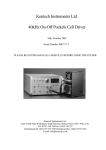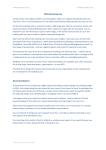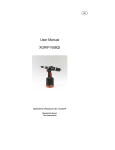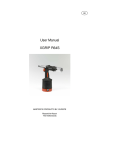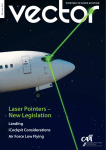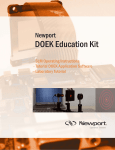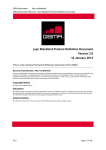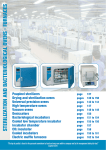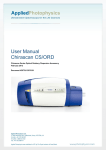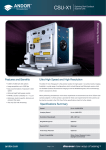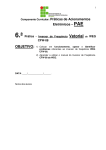Download UNIVERSITY OF SURREY DEPARTMENT OF PHYSICS Level 1
Transcript
UNIVERSITY OF SURREY DEPARTMENT OF PHYSICS Level 1 Laboratory: Classic Experiment C MEASUREMENT OF THE VELOCITY OF LIGHT 1. AIMS 1.1 Physics This is one of a set of three “classic” experiments in physics which you will repeat using modern apparatus. Here, you will measure the velocity of light, c, by using a modern form of Foucault's rotating mirror method (including a laser as a convenient bright and highly-directional light beam - not available in Foucault’s day!) With care in setting up the apparatus, you should be able to achieve a value for c with an overall error of 5% or less. 1.2 Skills The particular skills you will start to acquire by performing this experiment are: • The ability to follow detailed instructions carefully and in sequence • The careful setting up and alignment of optical equipment, including the use of polarising filters to control image brightness • Use of a measuring microscope to record small deflections • Researching the historical background of this experiment • Calculation and error assessment IMPORTANT NOTES This experiment uses a laser as the light source. Although the laser is of low power it is essential to observe the usual precautions: never look into the unattenuated laser beam, either directly or via reflection ; ensure that the laser beam does not traverse an area where someone might accidentally look into it. Of all Level 1 experiments, this one repays care in setting up and aligning the apparatus, and attention to points such as cleaning up the image and compensating for backlash in the micrometer, by yielding improved accuracy. Last updated Nov 2007 by TJCH Page 1 of 12 2. INTRODUCTION The speed of light is one of the most important and intriguing constants of nature. Whether the light comes from a laboratory laser or from a star hurtling away from the Earth at a fantastic speed, the measured speed of light c (in vacuo) is always the same. It is independent of the relative velocities of the light source and the observer. Einstein, in his Special Theory of Relativity, suggested that the speed of light was critically important in some surprising ways. In particular: (i) (ii) It establishes an upper limit to the velocity that may be imparted to an object. Objects moving at close to the speed of light follow a set of physical laws drastically different from Newton's Laws - and most people's intuition! Through most of history, those few people who thought about the speed of light considered it to be infinite. One of the first scientists to question this assumption was the Italian physicist Galileo, who in 1667 attempted to measure c.[1,2] Galileo was only able to show that c was far greater than his technique could measure. The time taken to stop and start the light beam (in his case the reaction times of the experimenters), was much larger than the transit times of the beam. Most subsequent attempts to determine c have worked by rapidly "chopping" the beam using rotating toothed wheels, spinning mirrors or prisms, Kerr cells etc.[1] The method you are going to use is a modification of the spinning mirror method originally devised by the French physicist J.J. Foucault in 1860. It has been updated by the inclusion of a laser as a light source and a modern high speed mirror. The basic arrangement is shown below in Figure 1.[3] Fm Rm Figure 1: Schematic Diagram of the Apparatus. The light from the laser is directed onto a rotating mirror Rm, from which it is reflected to a fixed mirror Fm a few metres away. On its return path the light again strikes Rm, which has by now turned through a small angle, so that the final image at s' will be slightly displaced, by an amount which depends upon the geometry of the apparatus, the angular velocity of Rm, and the transit time of the light between Rm and Fm. Hence, by measuring the displacement of the returned beam, the speed of light can be found. Page 2 of 12 3. DESCRIPTION OF THE APPARATUS Figure 2 below shows the components of the Pasco speed of light kit.[3] Before proceeding further, identify all of these in the provided kit, and read the text below. Figure 2: The Pasco Components. 3.1 The rotating mirror (Do not attempt to run the motor at this stage) This mirror, Rm , comes with its own control box. The mirror is flat to within ¼ of the laser wavelength, and spins in high speed bearings up to a maximum of about 1500 revolutions per second. The power supply and mirror mounting incorporate an optical pick-up and digital display which indicates the rotation speed to within 0.1%. The direction of rotation is reversible and continually variable up to 1000Hz, while a MAX REV button permits temporary speed increase to about 1500Hz. The rotating mirror motor assembly may have a plastic screw which locks the motor pulley in place – this should be loose (or removed) so that the mirror is free to rotate. 3.2 The measuring microscope A ×90 microscope mounted on a micrometer stage allows precise measurement of the image displacement. Fine cross hairs in the field of view, which can be focussed by sliding the eyepiece tube up or down, in conjunction with the micrometer, permit displacement to be resolved to within ±0.005mm. Page 3 of 12 The microscope stage also contains a partially-silvered mirror which both reflects and transmits, called a beam splitter. By positioning the side adjusting lever, the beam splitter can be oriented at an angle of 45° to the light reflected back from the rotating mirror, so that the image is correctly reflected directly up into the microscope (see Fig. 1) 3.2 The fixed mirror The mirror Fm is front silvered and is mounted on a stand provided with x and y alignment screws. The stand can be fixed to the bench with a “G-clamp”. 3.3 Optical bench A 1m optical bench provides a flat and level surface for aligning the optical components. The rear raised edge of the bench is used to assist alignment. 3.4 Laser This is a 0.5mW helium-neon laser with output in the red at a wavelength of 632.8nm, and attaches magnetically to the optical bench. 3.5 Alignment jigs and component holders These also attach magnetically to the optical bench. The component holders allow the mounting and alignment of the lenses and polarisers. Page 4 of 12 4. THEORY To understand the theory of this experiment it helps to simplify Fig. 1, exaggerate the angles, and change the distance scales, as shown in Figure 3 below. Fm δθ D 1 2 1' ∆S 2δθ 2δθ 2 δs 1 2' Figure 3: s Plane of final image Rm F'm 1 L2 Simplified optical path First consider that the rotating mirror Rm is stationary at some angle which sends the beam to a particular spot on the fixed mirror Fm. Call this beam 1. The fixed mirror Fm then reflects beam 1 back along its original path - towards Rm (a total round-trip distance of 2D) and thence back the plane of the final image s. Now let Rm be continuously rotating counter-clockwise, at angular frequency ω. Note this will cause the reflected laser beam to be spread out into a “fan” of beams lying in the plane of the original rays. One of these beams, however (corresponding to the same angle of Rm when it was fixed) will follow the original path of ray 1 and still strike the same point on Fm , and be reflected back along its original path towards Rm. However, meanwhile Rm has now turned through a small angle δθ. This will cause beam 1 returning back from Fm and reflecting off Rm to be deflected, also counter-clockwise, but by twice this angle, 2δθ. This deflected beam, ray 2 - the dashed arrows in Fig. 3 – will be focussed by lens L2 to a different spot in the plane of the final image, which is displaced from its original position by an amount δs, say. However, it helps to consider the whole optical path as a straight line. We do this by extending rays 1 and 2 backwards beyond Rm to the virtual image of Fm, i.e. F’m (which is still a distance D away from Rm - see the dotted lines to the left in Fig. 3.) We now see that, as far as lens L2 is concerned, ray 2 appears to be coming from a different spot on F’m, which is displaced from its original position by an amount ∆S, say. Since D is in reality a large distance, ∆S is given by : ∆S = D (2δθ ) Page 5 of 12 (1) We can now imagine that ∆S represents the size of an object in the plane of F’m that is imaged by lens L2 to a final image of size δs (which is actually in the plane of the cross hairs – the interposed beam splitter is omitted in Fig. 3). By applying the simple thin lens formula, this final image will be of size equal to ∆S de-magnified by a factor equal to the ratio of the image and object distances of lens L2, i.e. A / (B+D). Thus, δs is given by : δs = A 2 D δθ ( B + D) (2) Now, δθ is the angle through which the mirror rotates (at angular velocity ω) in the time it takes for light to make the round-trip between Rm and Fm (which is 2D/c), i.e. : δθ = 2D ω c (3) Combining equations (2) and (3) we then obtain: δs = A 4 D 2ω × (B + D ) c (4) Finally, consider what would happen to the final image if the mirror were rotating clockwise instead. Then the displaced spot would be not be above ray 1 in the plane of the final image in Fig. 3, but below. Thus, if we change the rate of rotation of mirror Rm from f1 Hz clockwise to f2 counter-clockwise (where ω = 2πf ), the total distance δstot between these two extreme displaced spots may then be written from Equ. (4) as : δs tot = 8πAD 2 ( f 1 + f 2 ) (B + D ) c Page 6 of 12 (5) 5. ALIGNMENT PROCEDURE N.B. Proper alignment is critical, not only for getting good results, but for getting any results at all. So follow the procedure below carefully and fully. Do not rush. Figure 4 below shows the general arrangement of the components. All components, as they are mounted on the bench, should be pushed back flush against the rear rail of the bench, thus ensuring that they are at right angles to the axis of the beam. Rm Figure 4: General arrangement of optical bench components. Check that the bench is on a flat and level surface and that the rotating mirror assembly and laser are mounted at opposite ends of the bench. Align the front edge of the rotating-mirror mounting with the 17cm mark on the bench. 5.1 Laser alignment Place the two alignment jigs at opposite ends of the bench, as shown in Figure 5. Rm Figure 5: Positioning the alignment jigs to align the laser. Turn on the laser and ensure that the beam block at the top/front of the laser is fully opened. Adjust the front end of the laser so that the beam passes through the hole in the first, nearest, alignment jig. To adjust the vertical aim of the laser, use the front levelling screws. If it is necessary to adjust the beam horizontally, slide the front of the laser slightly sideways on the bench. In a similar fashion, next adjust the rear end of the laser so that the beam passes through the second, farthest, alignment jig. Page 7 of 12 5.2 Rotating mirror alignment check The rotating mirror motor assembly may have a plastic locking-screw in place against the motor pulley – check that this is loose (or removed). The rotating mirror Rm should have its axis of rotation vertical and perpendicular to the beam. To check this, remove the alignment jig nearer the mirror and rotate the mirror (make sure that you are using its reflecting side) to check that the beam reflects back to a spot at the same height as the hole in the first jig near the laser. If it is slightly too low, for example, you can use thin paper as shims under the front of the mirror mounting (near the 17cm mark) to raise the reflected beam to the same height as the hole in the jig, as shown schematically below in Figure 6. Figure 6: Rotating Mirror Alignment 5.3 Lens mounting Remove the remaining alignment jig and mount the 48mm focal length lens (L1) so that the centre line of the component holder lines up with 93.0cm mark on the optical bench (see Fig. 4). Without moving the holder, slide the lens vertically or horizontally on the holder as necessary to centre the beam on the rotating mirror Rm. Note that the beam is now spread out to cover most of this mirror. Now mount the 252mm focal length lens (L2) with its holder lined up with the 62.2cm mark (see Fig. 4). Adjust this lens, as for L1, so that the beam is again centred on Rm. 5.4 Mounting the microscope Place the microscope on the optical bench so that the left hand edge of its mounting stage is aligned with the 82.0cm mark (see Fig. 4). Turn the beam splitter lever so that the partially-silvered beam splitter mirror is at 45° to the beam – see Fig. 1 and note the orientation of beam splitter : it should direct the beam reflected from Rm up into the microscope. Caution : do not look through the microscope at this stage. Since inserting the beam splitter may slightly deflect the beam, re-adjust L2 if necessary to centre the beam back onto Rm. Page 8 of 12 5.5 Adjusting the fixed mirror Place the fixed mirror Fm at about 3 to 4 m from Rm as shown below in Figure 7. Fm Rm Figure 7: Positioning the Fixed Mirror The angle between the bench axis and the line from rotating to fixed mirrors should be about 10 -12°. Turn Rm so that the main (i.e. brightest) laser spot hits Fm near its centre. (A piece of paper just in front of Fm makes it easier to see the spot). Ignore any other, weaker, spots which can arise from extraneous multiple reflections from the glass window of the rotating mirror protective housing, the lenses and other optical components. Keeping the paper over Fm , slide L2 backwards and forwards along the bench to focus the spot to the smallest possible point on the fixed mirror. Two people are necessary for this adjustment, one adjusting L2 and the other observing the sharpness of the spot. Then, clamp Fm to the bench and carefully use the x and y adjustment screws on the back of Fm to adjust the reflected beam so that it returns to Rm and strikes it centrally. Again, two people are needed. 5.6 Focusing the microscope Place the two polarisers, both attached to opposite sides of a single component holder, between the laser and the microscope (see Fig. 4), having first set them so that their axes are “crossed” – i.e. at right angles to each other, so that almost no light can pass through them. The purpose of the polarisers is to dim the laser light to an acceptable level so that it can be viewed comfortably through the microscope. With the polarisers crossed, it is now ok to look into the microscope. Now, carefully rotate one polariser until the image in the microscope brightens enough to view clearly. Do not rotate the polariser axes so that they are completely parallel to each other, or remove the polarisers, while looking through the microscope (until the mirror is rotating – see section 6B later) as the laser beam will become too bright to view comfortably. Page 9 of 12 Focus on the cross hairs of the microscope, and then focus the whole instrument by carefully sliding it up or down in its mounting tube (not forgetting to loosen its locking-screw first). If the equipment is properly aligned you will see a point image a spot. It is important to get this as sharp as possible. Note that, in addition to the desired spot image, you may also see other images, due, for example, to reflections of the laser beam from L1. To make sure that you are viewing the correct image, block the beam between Rm to Fm. If the spot you are looking at in the microscope does not disappear, it is not the right image. 5.7 Cleaning up the image In addition to the desired spot image you may also see interference fringes - these should cause no problems as long as the spot is clear and sharp, but they can sometimes be removed by slightly twisting the mounting of L2 so that it is no longer exactly at right angles to the axis of the beam. 5.8 What to do if you can not find the spot image? Try varying the tilt of the beam splitter, using the lever, by a few degrees. Try turning the micrometer knob to bring the image into the field of view. Try sliding the microscope mount a cm or so in either direction along the bench. Make sure that the mounting remains flush with the rear fence. If these minor adjustments don’t work re-check that : the spot on Fm is as sharply focussed as you can get it (by sliding the position of L2 backwards and forwards along the bench) ; that the beam reflected back from Fm strikes Rm as centrally as you can get it (by adjusting the x and y adjustment screws on the back of Fm.) If none of this helps, the initial alignment is probably not good enough and you had best start again from the beginning of section 5. 5.9 Component placement – summary As a final reminder, Fig. 4 shows the approximate positions of the components on the optical bench when the set-up is complete. Page 10 of 12 6. MAKING THE MEASUREMENT A With the apparatus aligned, and the spot image in sharp focus in the microscope, viewed roughly centrally on the cross-hairs, set the direction switch on the rotating mirror control box to clockwise (CW) and switch on the motor. Allow the mirror to warm up at about 600Hz for about 3 minutes. B While the motor is warming up observe the image in the microscope. The spot image should still be clear but will have also gone dimmer – therefore, carefully lift off the polarisers to allow more light through the system.(*) C Slowly increase the speed of rotation and note how the spot deflection increases (since Rm now turns through a larger angle during the time it takes for the light to travel from Rm to Fm and back). D Turn the ADJUST knob to bring the rotational speed up to about 1000Hz, then push the MAX REV button and hold it down. The speed should now increase to around 1500Hz. As soon as the speed is steady, record its value f1 and adjust the micrometer to centre the spot image on the cross hairs. Turn off the motor and carefully note the micrometer reading. Important Notes (1) Never hold the MAX REV button down for more than a minute at a time, or the motor may overheat. (2) When adjusting the micrometer screw, always approach the final setting from the same direction to eliminate backlash in the mechanical system. i.e. if you go past the correct setting of the cross hairs, wind the screw back well back beyond the other side of the spot image and re-approach in the original direction. E With Rm stationary, reverse the rotation direction switch to counter-clockwise (CCW) and repeat step D. Hence, find the total deflection of the image at s, δstot , as f is changed from f1 CW to f2 CCW. F Record all of the dimensions of the apparatus shown in Figs. 3 and 7, i.e. : A = distance from : B = " " D = " " G (*) L1 to L2 , minus the focal length of L1 L2 to Rm Rm to Fm Substitute your data into Equ. (5) and calculate c. Try to obtain about 3-4 sets of measurements of δstot and f , and find the mean value for the speed of light. When the motor is running the spot may become slightly more “smeared”, but should still be quite distinct. However, if the spot disappears, then switch the motor off, wait for Rm to stop, re-align it to aim the beam back onto Fm, and return to section 5.8 to re-check the alignment. Page 11 of 12 H Carefully assess the error in your measurement. What is the most significant source of uncertainty? Discuss with a demonstrator how you might set up the experiment to reduce this error. If time permits this may be tried out! I Look up the details of Michelson's rotating prism method for determining c and comment on why such a technique is inherently superior to that of Foucault. 7. REFERENCES [1] R.S. Longhurst, Geometrical and Physical Optics, Longman (3rd Edition, 1973). [2] H.C. Ohanian, Physics, W.W. Norton & Company (2nd Edition, 1989) p.873. [3] Pasco Scientific, user manual for the Foucault Method Speed of Light Apparatus, models OS-9261, 9262 and 9263A. Page 12 of 12














